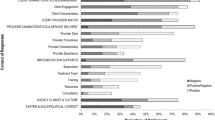Abstract
Social work educators are charged with preparing the next generation of clinical practitioners, since social workers provide the majority of the nation’s mental health services. Yet little is known about the “soil” onto which instruction falls—the ideas about mental disorder that MSW students bring to their clinical assessment courses. Without understanding the concepts that students already have, it is difficult to know how material is actually assimilated and translated into practice. Thus, a survey was conducted of MSW students (N = 388) at three graduate programs in the Northeastern U.S. Responses to open-ended questions were analyzed by iterative thematic analysis. Differences among response patterns at the three sites, corresponding to demographic differences among the students, suggest that both personal and work experience profoundly affect students’ views of disorder; specifically, the experiences of race and privilege may be crucial to the development of MSW students’ thinking about the nature of mental disorder and clinical knowledge. Implications for teaching and learning are offered.
Similar content being viewed by others
References
Berlin, S. B., & Marsh, J. C. (1993). Informing practice decisions. New York: MacMillan.
Black, P. N., Jeffreys, D., & Hartley, E. K. (1993). Personal history of psychosocial trauma in the early life of social work and business students. Journal of Social Work Education, 29(2), 171–180.
Bogo, M., & Wayne, J. (2013). The implicit curriculum in social work education: The culture of human interchange. Journal of Teaching in Social Work, 33(1), 2–14.
Boyatzis, R. E. (1998). Transforming qualitative information: Thematic analysis and code development. Thousand Oaks CA: Sage.
Council on Social Work Education. (2011). 2010 Statistics on social work education in the United States: A summary. Alexandria, VA: Council on Social Work Education.
Covarrubias, R. (2011). Mental health stigma about serious mental illness among MSW students: Social contact and attitude. Social Work, 56(4), 317–325.
Drolin, C. S. (1993). The effect of educational setting on student opinions of mental illness. Community Mental Health Journal, 29(3), 223–234.
Fereday, J., & Muir-Cochrane, E. (2006). Demonstrating rigor using thematic analysis: A hybrid approach of inductive and deductive coding and theme development. International Journal of Qualitative Methods, 5(1), 80–92.
Fox, R. (2013). The call to teach: Philosophy, process, and pragmatics of social work education. Alexandria, VA: Council on Social Work Education.
Gitterman, A. (2004). Interactive andragogy: Principles, methods, and skills. Journal of Teaching in Social Work, 24(3/4), 95–112.
Giummarra, M. J., & Haslam, N. (2005). The lay concept of childhood mental disorder. Child Psychiatry and Human Development, 35(3), 265–280.
Haslam, N., & Giosan, C. (2002). The lay concept of “mental disorder” among American undergraduates. Journal of Clinical Psychology, 58(4), 479–485.
Horton, G., Diaz, N., & Green, D. (2009). Mental health characteristics of social work students: Implications for social work education. Social Work in Mental Health, 7(9), 458–475.
Hugo, M. (2001). Mental health professionals’ attitudes towards people who have experienced a mental health disorder. Journal of Psychiatric and Mental Health Nursing, 8(5), 419–425.
Knowles, M. (1984). Andragogy in action. San Francisco: Jossey-Bass Publishers.
Norcross, J. C. (2005). The psychotherapist’s own psychotherapy: Educating and developing psychologists. American Psychologist, 60(8), 840–850.
Orlinsky, D. E., Schofield, M. J., Schroder, T., & Kazantzis, N. (2011). Utilization of personal therapy by psychotherapists: A practice-friendly review and a new study. Journal of Clinical Psychology. In Session, 67(8), 828–842.
Phillips, S. B. (2011). Up close and personal: A consideration of the role of personal therapy in the development of a psychotherapist. In R. H. Klein, H. S. Bernard, & V. L. Schermer (Eds.), On becoming a psychotherapist: The personal and professional journey (pp. 144–164). New York: Oxford University Press.
Probst, B. (2013). “Walking the tightrope:” Clinical social workers’ use of diagnostic and environmental perspectives. Clinical Social Work Journal, 41(2), 184–191.
Regehr, C., Stalker, C. S., Jacobs, M., & Pelech, W. (2001). The gatekeeper and the wounded healer. The Clinical Supervisor, 20(1), 127–143.
Russel, R., Gill, P., Coyne, A., & Woody, J. (1993). Dysfunction in the family of origin of MSW and other graduate students. Journal of Social Work Education, 29(1), 121–129.
Sedgwick, D. (1994). The wounded healer: Countertransference from a jungian perspective. New York: Routledge.
Sellers, S. L., & Hunter, A. G. (2005). Private pain, public choices: Influence of problems in the family of origin on career choices among a cohort of MSW students. Social Work Education: The International Journal, 24(8), 869–881.
Shera, W., & Delva-Tauilili, J. (1996). Changing MSW students’ attitudes towards the severely mentally ill. Community Mental Health Journal, 32(2), 159–169.
Strozier, A. L., & Stacey, L. (2001). The relevance of personal therapy in the education of MSW students. Clinical Social Work Journal, 29(2), 181–195.
Wakefield, J. C., Kirk, S. A., Pottick, K. J., Hsieh, D. K., & Xin, T. (2006). The lay concept of conduct disorder: Do nonprofessionals use syndromal symptoms or internal dysfunction to distinguish disorder from delinquency? Canadian Journal of Psychiatry, 51(4), 210–217.
Werrbach, G. B., & Depoy, E. (1993). Social work students’ interest in working with persons with serious mental illness. Journal of Social Work Education, 29(2), 200–211.
Author information
Authors and Affiliations
Corresponding author
Rights and permissions
About this article
Cite this article
Probst, B., Balletto, C. & Wofford, N. What They Bring: How MSW Students Think About Mental Disorder and Clinical Knowledge. Clin Soc Work J 43, 419–430 (2015). https://doi.org/10.1007/s10615-015-0517-6
Published:
Issue Date:
DOI: https://doi.org/10.1007/s10615-015-0517-6



